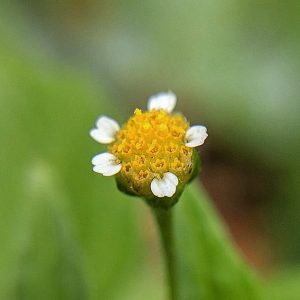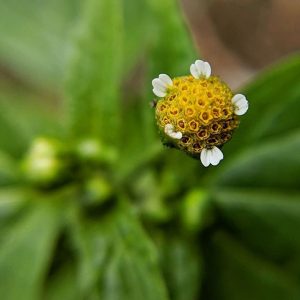Gallant Soldier (Galinsoga parviflora), a Central American annual herb now distributed throughout the temperate and subtropical world as a consequence of 19th century botanical and agricultural trade.
Gallant Soldier was reportedly introduced to Europe as a botanical collection, with its introductions to both France and England coming through respective escapes from the botanic gardens at Paris (Damalas 2008) and Kew (Mabey 1996). Once loose, the plant became a major agricultural weed affecting various cash crops and orchards. Purportedly referred to briefly in England as ‘Kew Weed’, the name ‘Gallant Soldier’ is apparently a corruption of its latin appellation honouring the c. 1780s superintendent of the Royal Botanical Garden of Madrid, and of the vernacular name ‘French Soldier’, in parallel to whom the plant had spread across Europe at the time of the Napoleonic Wars.
In Australia, Galinsoga parviflora was recorded in Queensland in 1868, and in NSW and WA in the 1880s; its relatively frequent mention in the early newspaper columns of coastal Queensland implies that it quickly became widespread there. These early Australian accounts call it ‘Annual Mercury’ or ‘White Tops’; a later description in the Brisbane Courier in 1931 labels G. parviflora ‘Yellow Weed’ and decried it as a ‘cosmopolitan guest of the garden’ with its ‘florets combining in communistic fashion for the perpetuation of the plant.’
The first detailed record of Gallant Soldier within metropolitan Melbourne stems from a collection at the railway reserve at Sandringham in 1921, however the species was apparently never common in here in Victoria where the dominance of the paddock does not play to the plant’s strengths. Today the plant remains almost exclusively a weed of the metropolitan’s eastern arc, an area notable for its historical association with fruit-growing and, in the inner east, the presence of the RBG. The photographed plants were found in West Richmond.
View Original Post on Instagram
Search for information about Galinsoga parviflora in the Flora of Victoria
View information and occurrences of Galinsoga parviflora on the Atlas of Living Australia








